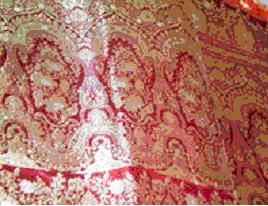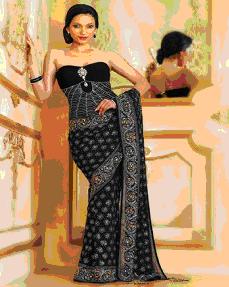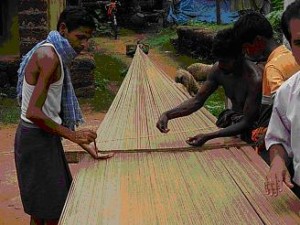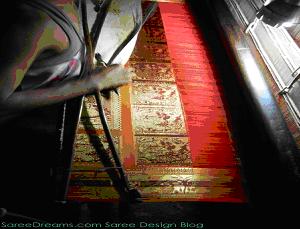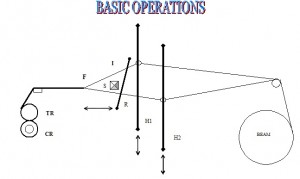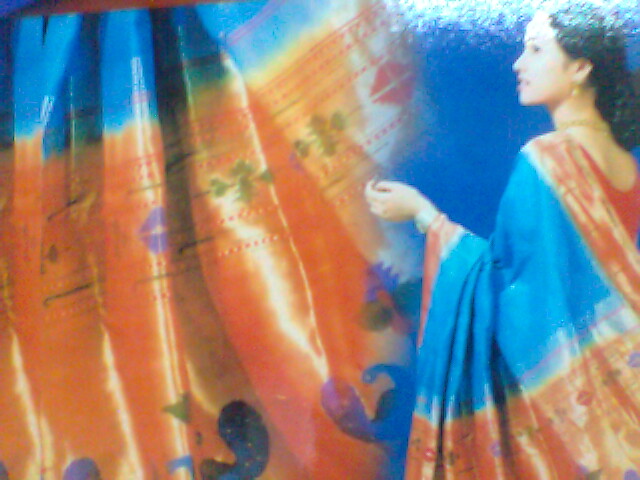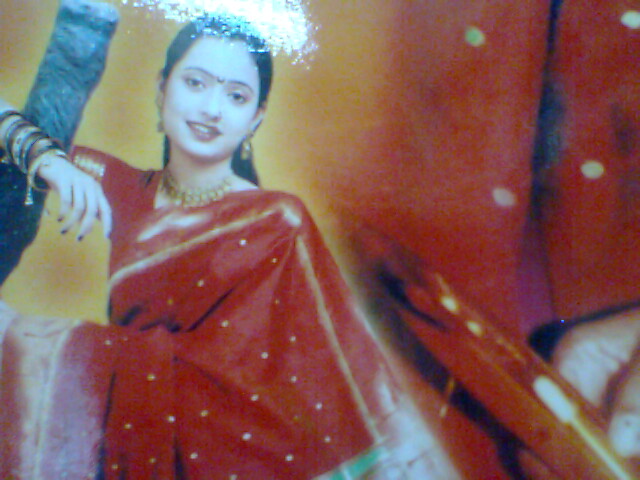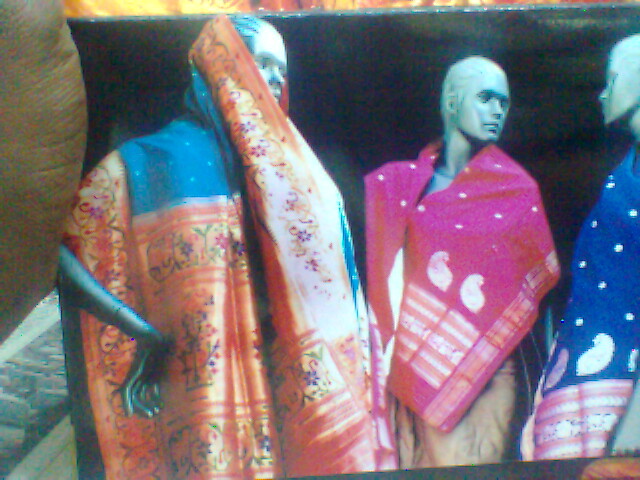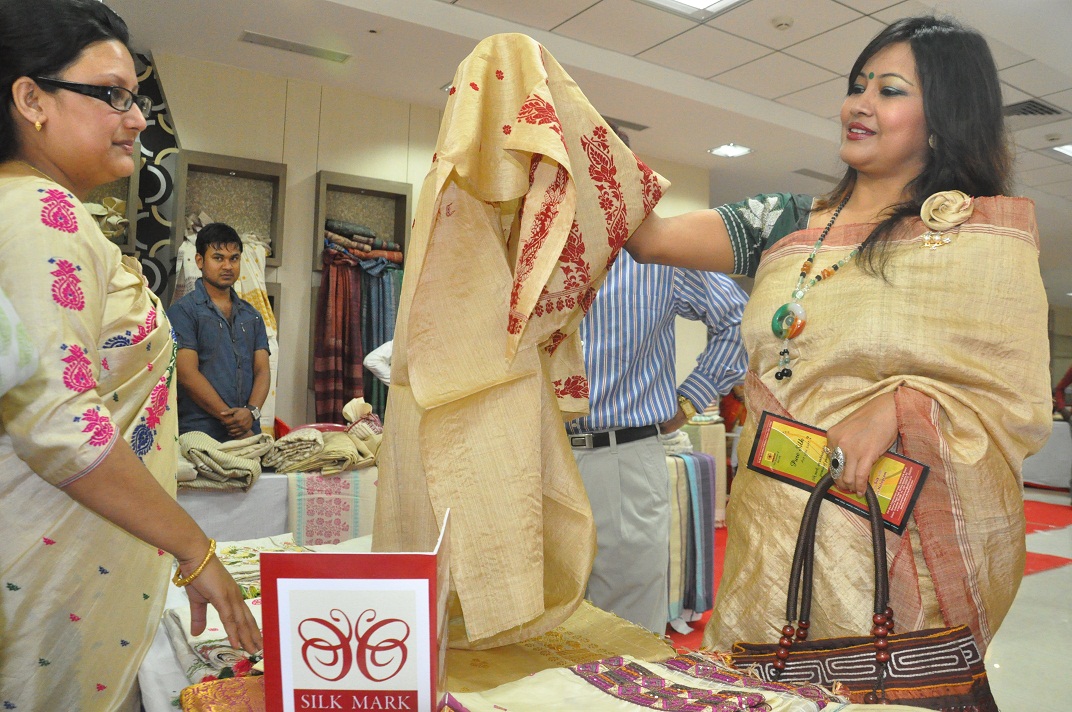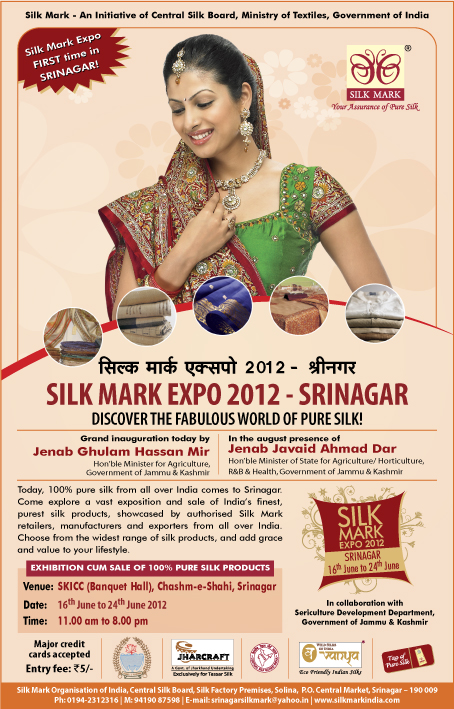by Chitra Balasubramaniam , a freelance journalist
[This article appeared in the earlier issue of Silk Mark Vogue]
Tasar silk is quite familiar to all of us, one of the most popular of silks today, tasar is liked for its inherent sheen, texture and of course the range of its natural colours. But how many of us are familiar with the fact that tasar was first discovered during the Indus Valley Civilisation? No this is not conjecture or just an off the cuff remark. It is an archaeologically proven fact recently. In a paper published titled New Evidence for Early Silk in the Indus Civilisation by I.L. Good, J.M. Kenoyer and R.H. Meadow in Archaeometry 51, 3 (2009), University of Oxford, talks of the use of silken threads in the Indus Valley Civilisation. To be precise, the words written by J M Kenoyer and R H Meadow are, “This unique discovery of a coiled copper-alloy wire necklace (H2000/2242-01) has traces of fibers preserved on the inside. Recent studies indicate that the fibers are from the wild silk moth, Antheraea mylitta, commonly called “Tasar” silk today (Irene Good, J. M. Kenoyer and R. H. Meadow 2008). This necklace dates to Harappa period 3B (circa 2450-2200 BC) and is the earliest evidence for silk in South Asia. Its discovery demonstrates that silk production may have first been used to make fine threads for necklaces and only later used for weaving fabrics. The copper wire on this necklace is also among the earliest evidence for finely made wire in the Indus Valley. This type of wire is likely to have been made by drawing the wire through a series of graduated perforations. (Source: www.harappa.com/indus3/218.html). A path breaking discovery indeed! A knowledge which instills in us a sense of pride at the antiquity of tussar which we take it for granted.
THE DEEP ROOTED LINK
The road from the silk yarn to the weave and innovation in its current form has traversed nearly over 4000 years. Today, the mantra is “Green” and organic – whether it is fabric, food or any other product, there is this emphasis on natural. The world is embracing natural fibers, yarns and fabrics with a vengeance. And the tasar fits in snugly into this definition of natural, organic silk, green fabric, wild silk… Every country is taking measures to boost its contribution to natural fibres both plant and animal. A further boost to the movement was given with the United Nations celebrating 2009 as the International year of Natural fibres. Tasar did find a place of pride in the listing. It is to the credit of tasar that it is as relevant and contemporary now as it was during the Indus Valley Civilisation.
India is a virtual treasure trove of silk, the only country in the world to produce both mulberry and the distinct types of non mulberry silk (Tasar, Muga and Eri). The grandeur tales of how India’s famed silks were exchanged for gold, silver and other precious metals is what history is made of. . Cut to the present, the mulberry silk rules the market with the non-mulberry varieties forming just a small portion of the production. What however undeniable is its “expensive, royal, sophisticated, very elite, exclusive image”. With these attribute associations; silk is more of an exclusive product, aimed at the niches in the higher end of the market. Tussar affords excellent potential in the domestic and export markets. The applications are varied, the innovations mind boggling, the design and motif potential unlimited. The potential of tasar as they say is yet to be unleashed! Unconvinced try this, at the recent Handloom fair during Dial at Dilli Haat, the predominant stalls were from the Tussar belt (Madhya Pradesh, Jharkhand, Chattisgarh, Bihar, West Bengal, Assam) now offered so much variation in tasar that it was unbelievable. Each stall had something different and the business – brisk with contemporary designs flying off like hot cakes. The range encompassed both fabrics, wearable tasar (salwar suits, shawls, stoles, sarees) to quilt fabrics, furnishing material and throws.
Tussar is produced by special silkworms – Antheraea mylitta and Antheraea proylei which feed on leaves other than the mulberry. The colour of the silk depends on the leaves on which the worms feed and the climatic conditions of the region where it is being reared. Thus the range of natural shades – ranging from cream, off white, light honey brown, deeper shades of brown, beige…It is slightly coarse (yes it is not smooth and soft like mulberry silk), given that it is reared in the wild – in the forest, it is also called Wild Silk. It has a natural sheen which gives the silk a very rich natural appearance. Internationally Tasar silk is called tussah or tusseah silk and is very popular amongst hand knitters and weavers. Tasar yarn has a huge export potential as it is combined with wool and other fancy yarns and is the preferred choice of knitters. The tasar yarn gives it the certain exotica. Popularly called Kosa silk, the areas of Raigarh, Bastar produce some of the finest quality of tasar – raila. Several weavers refer to this as desi. Tasar from Bhagalpur is legendary.
Historical Speak
Apart from its linkages to the Harappan Civilisation, Tasar has found a pride of place and has been mentioned in travel accounts of voyagers to India. It has also been extensively used in Exhibitions of Handicrafts held in the 19th and early 20th centuries. The use of Kosa or Tasar has been documented in writings on Industrial Arts of India and in Exhibition Catalogues of British Raj. Sir George Watt in his book Indian Art at Delhi 1903 talks of Central provinces, “the most important part of silk craft in these Provinces is the production and utilization of tasar in Bilaspur, Raipur, Sambalpur and Chanda Districts. In the Sambalpur tasar saris, the end-piece and borders are dyed yellow or crimson and occasionally blue. He also speaks of Amru silks of Benares which had tasar silk warp and weft of imported cotton. The Imperial Gazetteer of India Vol III Economics, quotes of embroidery with Tasar done on Lucknowi Chikan especially to fill the petals, of Bengal handloom factories which predominantly shifted to using tusar.
Kamala Devi Chattopadyay, the doyen of Indian Handicrafts, thanks to whose efforts a number of crafts are alive today, writes in her book Handicrafts of India, “Ganeshpur, in Bhandara district of Maharashtra, has almost half the working population engaged in tasar silk weaving. It is almost a monopoly of the koshti community. They too claim to be descended from sage Markanda known to have woven the first fabric from the lotus fibre to clothe the gods.” Tasar silk is also known by its Sanskrit name of Kosa.
Traditional leanings
Tasar has been used in traditional sarees, fabrics woven in the country. Orissa’s single ikkat – patola is woven in tussar. It is further adorned with motifs of fish, rudraksha, simple flowers, conch…. The colours use the natural colouration of tussar to vantage. Maharashtra tussar silk comes with an eye catching combination of again creamish to brown tussar silk with contrast borders in earthy maroons, orange, blue, green… the border further ornamented with rudraksha motifs or small kairies. In Bengal it is the base for Kantha embroidery. It works as a substitute for mulberry silk to bring down the cost. Kamala Devi Chattopadyay writes in the same book on some of the varieties in tasar weave, “motha choukada is a design in big squares, woven from the mixture of kosa yarn and mercerized cotton and lahan choukada is small squares. The gunja salai consists of diagonal designs on the cloth along with coloured lines at regular intervals, in green, blue or orange. Other varieties are teen-dhari choukada, the square patter, rasta choukada, squares with horizontal lines running through and so on.”
Today the ornate and complicated motif has its own admirers. The grand pallav, the body filled with motifs and bhutis routine is woven and bought with gusto. Here it is worked with lurex, kantha embroidery, Worli images, Madhubani paintings, Kalamkari, simple block prints, jacquard loom weaving…… The piece de resistance is the Orissa tasar saree – single ikat. These are available in natural shades of tussar with contrast ikat borders alter in single or short colours with ikat borders. “Kora” original coloured tasar sarees with woven borders are extremely popular amongst working women as it can be used for formal occasions and daily wear.
Contemporary Avtaar
What has seen Tussar emerge as a winner in recent times is the degree of innovation and experimentation that has taken place with tussar. Be it in yarn combinations, weave, colours and motifs. Tasar is being combined with manmade and natural fabrics. It is combined with pashmina (lena), muga silk, eri, it is teamed with wool, with lurex, noil, viscose, cotton and mulberry silk to create some exotic stoles, sarees and shawls. The introduction of Oak Tussar in areas not the traditional bastion of Tasar has given it a further boost. Oak tussar is being increasingly popularized in the Hills – Uttaranchal, Himachal Pradesh, Meghalaya, Manipur, Mizoram….. Oak tussar from Uttaranchal has seen innovations. The spearheading was done by NGOs working in this sector which roped in NID and NIFT designers to create some contemporary designs. Active in this area of weaving are several NGOs and co-operatives, including: Avani, Panchachuli, Appropriate Technology India, Kumaon Grameen Udyog. Similar innovation has also come up in the traditional tussar belt, leading the foray has been BMKS – Berozgar Mahila Kalyan Samiti, (BMKS), based in Bhagalpur, Bihar.
What stands out is that today tasar is combined with a variety of yarns which gives the products a definitive edge. It is this wealth of natural yarns with which the designers are really experimenting with. The tasar pashmina combination is increasingly being woven into sarees dyed in deep shades and with beautiful block prints. Given the novelty it is a hot seller as a weaver seller from Himachal Pradesh put it, “I don’t know why but this is very popular in Delhi, though finds little takers near our village.” It has also been experimented with mica prints.
HOME SPUN BRAND IMAGE
Apart from the combination of yarns, the experimentation with the weaving technique has given the tasar an entirely new look. Weaves commonly seen in fabric weaving are being applied to weaving saris. So there is twill, herringbone, satin, diamond which when combined with the interesting and different colour palette makes the creation stand out. The designs again are not ornate or extremely complicated, just the basic stripes, checks, squares are woven in beautiful colour combinations. A weaver reveals the range of designs as, “Chashma bulbul which is actually a bird’s eye, machli kanta – fishing hook, Dangching, khapa, simple lines and geometrical squares. Designs which have been lifted from Kullu are called well, Kullu designs, while that of Almora – Almora designs.” The entire length of the sari could be in this design or it could be mixed with simple plain weaving. The ornate and extremely complicated patterning is being done away with and in turn replaced by play with geometrics, basic stripes, checks, square with colour combinations. Combining two or more weaves in one shawl is very common. Also unlike typical shawls it does not lay emphasis on borders and ends. So reversal of techniques like motifed body of the shawl with plain borders, simple gingham checks, squares in bright colours are all part of the scheme.
EVER GREEN FASHION
Not to be left far behind are the combination of colours. Traditionally tasar has been woven in its natural colouring with value additions being done using block prints, painting, contrast coloured motif weaving or embroidery. The contemporary creations pick up the choicest of shades from the colour palette, combining it with unbridled freedom. Colours usually seen on international platforms or as colours of the season are now increasingly being seen on the desi versions. The weaving is no longer single colour or multiple but it is not unusual to see three to four shades along the warp and the weft. The result a riot of colour based gradation in the sarees and fabrics. So it is not unusual to see a shawl in green red where the warp is made of three different colours or vice versa with the three different shades used in the weft. It is this soft interplay of colours which gives it the very contemporary look. Similarly borderless sarees or sarees with single colour block borders, the body combining two or three shades of the same colour. Each of which is different and reverting. This beautiful base is further worked with over dyes, washes, embroidery, block printing, hand painting….So it is not unusual to see a tasar silk woven in Jharkhand then worked on by Kalamkari artists or Kasuti embroiderers or even sujni embroiderers. The result in an eclectic truly different piece. Some very interesting work using traditional chippa printing has been done by Raghunath Nama – Master Craftsman. An interesting outcome of several of these designs is that the saree or stole become do rookha and can be worn either ways. Like Tussar on the weft and and wool on the warp, do rookha style where the stole can be worn either ways. One weaver had come out with a saree which could actually be worn any way meaning the both ends could become the pallav, as also the do rookha interchanging of the sides; black with shot pink.
Further innovation is the use of natural dyes and vegetable colours. Though synthetic and chemical colours are used, there is a shift towards using only natural dyed colours. This has really caught on with the export market. So Walnut, Henna, Indigo, Madder, Harda…..are all being used to derive some beautiful colours. Some unusual colours not seen commonly in natural dyed fabrics can also be seen like pretty lilacs, turquoise blue, pinks etc.
Use in furnishing
Tasar is being increasingly used in the furnishing industry and very popular for made ups. It is very popular in accessories, throws, as fabrics for furnishing and of course for garments. The structure of the fabric allows it to be stitched in any form.
So the entire range, throws, cushion covers, upholstery material, curtains, quilts….gets made from it. It is also popular in patchwork and appliqué. Some international interior designers prefer the saree (tasar, over dyed, embroidered….) fabric to work into their own designs for the home. Given the emphasis on designs, weaves and colour combinations, the results are fabulous. The colour combination works to highlight the weaves very subtly, giving the piece a remarkably self design appearance.. Another fact which works in favour of tasar fabrics is the cost of experimentation is not very high. Ghisa and matka varieties are very popular in the furnishing market. What works for furnishing especially in the export market is that it is rich, has a natural earthy colouring both of which gives it that extra jazz. The colours bringing out the rugged look, patterns from textured effects, stripes to jacquard.
Tasar is haute and with experimentation will transcend greater heights. What is humbling is that the silk, over which we go gaga, where export targets are laid, is a silken thread which bridges the continuity of civilization. This year it found representation in the State Tableau of the Republic Day. From Indus Valley to the present day Republic Day Rally, it is indeed a thread of antiquity.

